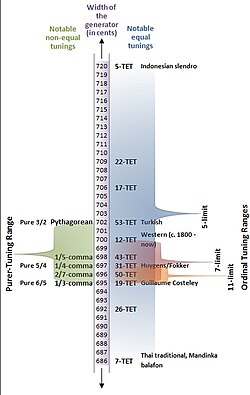
Back Escala pitagòrica Catalan Pythagorejské ladění Czech Pythagoreische Stimmung German Pitagora agordo Esperanto Afinación pitagórica Spanish Pythagorase häälestus Estonian Intonazio pitagoriko Basque کوک فیثاغورثی Persian Accord pythagoricien French Püthagoraszi hangolás Hungarian



Pythagorean tuning is a system of musical tuning in which the frequency ratios of all intervals are based on the ratio 3:2.[2] This ratio, also known as the "pure" perfect fifth, is chosen because it is one of the most consonant and easiest to tune by ear and because of importance attributed to the integer 3. As Novalis put it, "The musical proportions seem to me to be particularly correct natural proportions."[3] Alternatively, it can be described as the tuning of the syntonic temperament[1] in which the generator is the ratio 3:2 (i.e., the untempered perfect fifth), which is ≈ 702 cents wide.
The system dates to Ancient Mesopotamia;[4] see Music of Mesopotamia § Music theory. The system is named, and has been widely misattributed, to Ancient Greeks, notably Pythagoras (sixth century BC) by modern authors of music theory, while Ptolemy, and later Boethius, ascribed the division of the tetrachord by only two intervals, called "semitonium", "tonus", "tonus" in Latin (256:243 × 9:8 × 9:8), to Eratosthenes. The so-called "Pythagorean tuning" was used by musicians up to the beginning of the 16th century. "The Pythagorean system would appear to be ideal because of the purity of the fifths, but some consider other intervals, particularly the major third, to be so badly out of tune that major chords [may be considered] a dissonance."[2]
The Pythagorean scale is any scale which can be constructed from only pure perfect fifths (3:2) and octaves (2:1).[5] In Greek music it was used to tune tetrachords, which were composed into scales spanning an octave.[6] A distinction can be made between extended Pythagorean tuning and a 12-tone Pythagorean temperament. Extended Pythagorean tuning corresponds 1-on-1 with western music notation and there is no limit to the number of fifths. In 12-tone Pythagorean temperament however one is limited by 12-tones per octave and one cannot play most music according to the Pythagorean system corresponding to the enharmonic notation, instead one finds that for instance the diminished sixth becomes a "wolf fifth".
- ^ a b Milne, Andrew; Sethares, W.A.; Plamondon, J. (December 2007). "Invariant Fingerings Across a Tuning Continuum". Computer Music Journal. 31 (4): 15–32. doi:10.1162/comj.2007.31.4.15. S2CID 27906745. Retrieved 2013-07-11.
- ^ a b Bruce Benward and Marilyn Nadine Saker (2003). Music: In Theory and Practice, seventh edition, 2 vols. (Boston: McGraw-Hill). Vol. I: p. 56. ISBN 978-0-07-294262-0.
- ^ Kenneth Sylvan Guthrie, David R. Fideler (1987). The Pythagorean Sourcebook and Library: An Anthology of Ancient Writings which Relate to Pythagoras and Pythagorean Philosophy, p. 24. Red Wheel/Weiser. ISBN 9780933999510.
- ^ Dumbrill 1998, p. 18.
- ^ Sethares, William A. (2005). Tuning, Timbre, Spectrum, Scale, p. 163. ISBN 1-85233-797-4.
- ^ Frazer, Peter A. (April 2001). "The Development of Musical Tuning Systems" (PDF). Archived from the original (PDF) on 2006-05-06. Retrieved 2014-02-02.
© MMXXIII Rich X Search. We shall prevail. All rights reserved. Rich X Search

